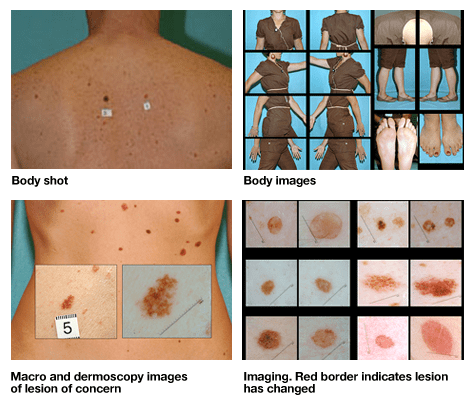Mole Mapping

Keeping an Eye on Your Skin: The Importance of Mole Mapping
The detection of melanoma can sometimes be challenging even for professionals. There are various methods for the early diagnosis of melanoma, including annual full-body skin exams with a healthcare provider and monthly skin self-exams. One of the more advanced methods is mole mapping. Mole mapping is a painless and noninvasive approach to help detect melanoma that uses whole body photography to identify new moles and track changes in existing moles. Not all insurances cover mole mapping, but if yours does, and if your healthcare provider offers mole mapping, it may be a good option for you for early detection.
What Is Mole Mapping?
Mole mapping is a non-invasive procedure that uses specialized imaging technology to capture high-resolution images of your skin. These images are then analyzed by your dermatologist to identify any changes in moles or skin spots.The images are stored in a digital database. This process is typically done on an annual basis to track any changes over time. Patients leave with a flash drive containing their photos and use them when they perform self-skin exams to compare their photos to their current skin.
Your follow-up exams will include further photographs to assess changes in moles as time progresses. By tracking changes in moles and skin spots, dermatologists can identify potential signs of skin cancer before it becomes a more serious issue. This allows for early treatment and a higher chance of successful outcomes.
The Process
The mole mapping process is quick and painless. A dermatologist will use a specialized camera to take images of your skin, focusing on any moles or skin spots. These images are then analyzed and compared to previous images to track any changes. The entire process typically takes less than 30 minutes.

Who Should Get Mole Mapping?
Mole mapping is recommended for anyone with a history of skin cancer in their family, a large number of moles or skin spots, or a history of excessive sun exposure. It is also recommended for those with fair skin, as they are at a higher risk for skin cancer. However, anyone can benefit from mole mapping as it provides a comprehensive and detailed analysis of your skin.
Whether or not you have mole mapping done, you should have your moles checked by your healthcare provider annually at a full body exam, and you should check them monthly yourself during a self-exam.
- Do you have multiple moles (more than 50)?
- Do you have atypical or dysplastic nevi – moles that are large or of unusual color(s) or shapes?
- Do you have moles on your back, which may be difficult to keep an eye on?
- Is there a history of melanoma in your family?
- Have you been diagnosed with melanoma?
- Do you have any large moles (diameter more than 2 inches)?
- Have you noticed any changes in your moles?
- Have you noticed any new mole on your body?
- Did you have any severe sunburns during childhood or adolescence?
- Do you have light-colored skin that easily burns?
- Do you have a weakened immune system due to an organ transplant, cancer, chemotherapy, or human immunodeficiency virus (HIV)?
- Have you ever used an indoor tanning bed?
Peace of Mind
For many people, the thought of melanoma or other skin cancers can be scary. Mole mapping can provide peace of mind by regularly monitoring your skin for any changes. This can help alleviate any anxiety or worry about potential melanoma and allow you to take proactive steps to protect your skin.
Mole mapping helps alert your dermatologist to a potential melanoma at the earliest possible stage. Melanoma commonly develops in an existing mole or lesion, and if it is not detected and removed early enough, it can spread to other organs in your body, where it is difficult to treat and often deadly.
Mole mapping is a crucial tool in the early detection of melanoma. By regularly monitoring your skin for changes, dermatologists can identify potential issues and provide proactive treatment. If you have a history of skin cancer in your family or are concerned about your skin, consider scheduling a mole mapping appointment with your dermatologist. Your skin is your body’s largest organ, and it’s essential to take care of it.

